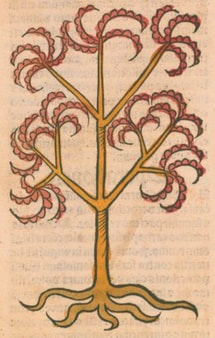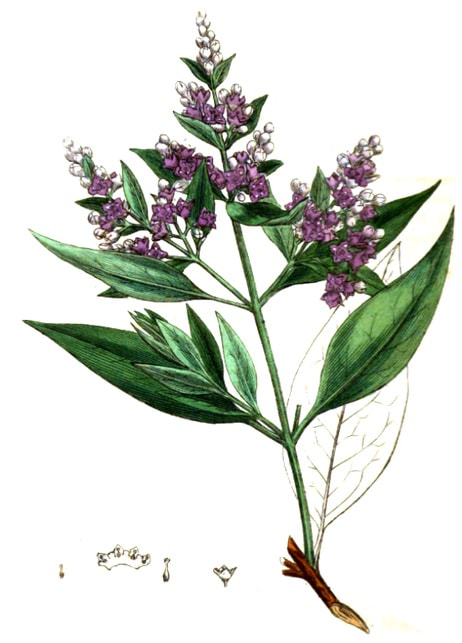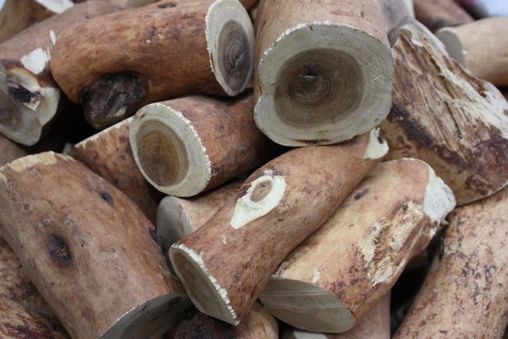Ortus Sanitatis, Meydenbach, 1491
Santalum album,
Medical Botany, Woodville, 1810
Medical Botany, Woodville, 1810
Australian Sandalwood available at the Chengdu Medicine Market (2010)
Botanical name:
Santalum album (White); S. citrinum (Yellow);
The Australian Sandalwood (S. spicatum, S. lanceolatum) are used and are available on the Chinese market.
See also Red Sandalwood, Pterocarpus santalinus
Parts used:
Wood
Temperature & Taste:
Cool (Warm in TCM), dry. Pungent, Aromatic, slightly Sweet
Classifications:
2A APERIENT. 2B ATTENUATERS. 2F. PURIFYING. 2H. CARMINATIVE. 2O. ASTRINGENT. 2P. HEMOSTATICS. 2S. STRENGTHENING.
3B. FEBRIFUGE & ANTIPYRETIC. 3D. CORDIALS & CARDIACS. 3F. LITHONTRIPTIC
4c. CARDIAC. 4d. PECTORAL. 4e. STOMACHIC. 4f. SPLENETIC. 4g. HEPATIC. 4h. NEPHRITIC. 4i. UTERINE. 4j. NERVINE
Santalum album (White); S. citrinum (Yellow);
The Australian Sandalwood (S. spicatum, S. lanceolatum) are used and are available on the Chinese market.
See also Red Sandalwood, Pterocarpus santalinus
Parts used:
Wood
Temperature & Taste:
Cool (Warm in TCM), dry. Pungent, Aromatic, slightly Sweet
Classifications:
2A APERIENT. 2B ATTENUATERS. 2F. PURIFYING. 2H. CARMINATIVE. 2O. ASTRINGENT. 2P. HEMOSTATICS. 2S. STRENGTHENING.
3B. FEBRIFUGE & ANTIPYRETIC. 3D. CORDIALS & CARDIACS. 3F. LITHONTRIPTIC
4c. CARDIAC. 4d. PECTORAL. 4e. STOMACHIC. 4f. SPLENETIC. 4g. HEPATIC. 4h. NEPHRITIC. 4i. UTERINE. 4j. NERVINE
ADVERTISEMENT:
Uses:
1. Clears Liver Heat: (all systems)
-it ‘Cools the Liver’ (Salmon); White Sandalwood is accounted a good Pitta/Heat relieving drug.
-Liver disease, Fevers associated with Liver heat, bilious conditions,
-Liver and Gall Bladder complaints (Commission E)
2. Clears Heat, Resists Poison (all systems)
-Acute Fever, Chronic and Epidemic Fever
-Tibetan Medicine and Ayurveda both recognise White Sandalwood as a main medicine for Heat and Fevers.
-"Sandalwood, specially its white variety is useful in Hot fevers". (Avicenna)
3. Moves the Blood and Qi, Clears Stasis, Benefits the Heart (all systems)
-chest pain, Palpitations, Angina Pectoris, Heart disease
-Cordial: said to ‘cause cheerfulness’ in Depression or Nervousness, especially when related to Heart weakness.
-in Tibetan formulas for Nervous and Mental disorders, Trembling, Paralysis and Epilepsy.
4. Clears Heat, Benefit the Lungs (TCM, West, Ayurveda, Tibetan Medicine):
-Coughs, chronic Bronchitis, Lung fever, Hectic fevers, Consumption, Lung ulcers (White)
-Cough, Cold, Bronchitis (Commission E)
-as a snuff in Tibetan formulas for Rhinitis and Sinusitis, and also for Colds and Influenza.
5. Clears Heat and Damp:
-acute heat of the Bladder, including Gonorrhea, chronic Cystitis, Urinary Tract Infections, Prostatitis, Vaginitis, urethritis
-Urinary Tract Infection (Commission E)
6. Moves the Qi, Regulates Digestion (TCM, West, Ayurveda, Tibetan Medicine):
-abdominal distention with Pain, Nausea, Indigestion, Vomiting and Stomachache
-‘Strengthens the Stomach’ (Salmon).
-Stomach weakness with Heat (Avicenna)
7. Externally:
-a paste can be applied to the temples in Headache or Migraine
-applied to Gout.
-a paste of the wood or the Oil is used as a cooling dressing in inflammatory and Eruptive Skin diseases including Erysipelas, Pruritus, Prickly Heat, Scabies etc. where it is said to be one of the best applications.
-clinically effective against acne, psoriasis, eczema, warts
-a mixture of Sandalwood Oil and Mustard Oil is good for Pimples.
-inflammation of the mouth and pharynx (Commission E)
Comment:
1. White and Yellow Sandalwood effect and move the Qi, the Red effects the Blood. White is most available and used, but the Yellow is better.
2. The White Sandalwood has an effect on Phlegm, the Yellow on Bile and the Red on Blood.
Dose:
Powder: 500mg–3 grams
Corrective:
... available in PRO version
Substitute:
... available in PRO version
1. White and Yellow Sandalwood effect and move the Qi, the Red effects the Blood. White is most available and used, but the Yellow is better.
2. The White Sandalwood has an effect on Phlegm, the Yellow on Bile and the Red on Blood.
Dose:
Powder: 500mg–3 grams
Corrective:
... available in PRO version
Substitute:
... available in PRO version
Main Combinations:
Rose, Sandalwood & Licorice
1. Heat and Bile disorders, Sandalwood with ... available in PRO version
2. Fever associated with Wind and Heat, Sandalwood with ... available in PRO version
3. For Stomach and Liver Heat with Qi stagnation, Sandalwood with ... available in PRO version
4. Liver Heat, and Heat in general:
i. Sandalwood with ... available in PRO version
ii. Sandalwood with ... available in PRO version
iii. White and Red Sandalwood with ... available in PRO version
5. Strengthen the Heart, Sandalwood with ... available in PRO version
6. Strengthen the Stomach, White Sandalwood with ... available in PRO version
7. For Catarrh, Consumption, Spitting Blood, and Diarrhea, Sandalwood with ... available in PRO version
8. Heat and Fever of the Lungs, White Sandalwood with ... available in PRO version
9. For Arthritis, Lower Back and Hip pain, Heat and inflammation of the Nerves or Blood ... available in PRO version
10. Threatened Miscarriage:
i. Sandalwood with ... available in PRO version
Major Formulas:
Cordial Powder
Powder for the Liver (Bononiense)
Powder to Cool the Liver
Powder to Cool the Heart
Abbots Confect of Rose (Diarrhodon Abbatis) (Nicholas)
Powder of Three Sandalwoods (Diatrisantalum) (Mesue)
Cooling Powder of Gems
Troches of Sandalwoods (Trochisci Santalon) (Mesue)
Troches of Rose (Trochisci Diarrhodon)(Nicholas)
Electuarium Dianthu (Galen)
Electuary to Restore Humidity (Arnold de Villa Nova)
Electuary of the Juice of Roses (Mesue)
Electuary for Head and Stomach Pain (Galen)
Sandalwood 8 (Tibetan Medicine)
Sandalwood 18 (Tibetan Medicine)
Aloeswood 15 (Tibetan Medicine)
Aloeswood Clear the Heart 8 Powder
ADVERTISEMENT:
Cautions:
1. In TCM, Sandalwood is not used in Deficient-Heat conditions. It is suitable for these conditions when combined with appropriate medicines as is evident from other Traditions.
2. All Sandalwoods decrease sexual activity with long-term use or in large doses.
Main Preparations used:
Gummy Extract, Ointment of Sandalwood, Plaster of Sandalwood
1. In TCM, Sandalwood is not used in Deficient-Heat conditions. It is suitable for these conditions when combined with appropriate medicines as is evident from other Traditions.
2. All Sandalwoods decrease sexual activity with long-term use or in large doses.
Main Preparations used:
Gummy Extract, Ointment of Sandalwood, Plaster of Sandalwood
Click the Tabs above for more information on this Medicine
|
'Sandal wood, the Sanskrit name for which, Chandana, has passed into many of the languages of India, is mentioned in the Nirukta or writings of Yaska, the oldest Vedic commentary extant, written not later than the 5th century B.C. The wood is also referred to in the ancient Sanskrit epic poems, the Ramayana and Mahabharata, parts of which may be of nearly as early date.
The author of the Periplus of the Erythrean Sea, written about the middle of the 1st century, enumerates sandal wood among the Indian commodities imported into Omana in the Persian Gulf. The [?] mentioned towards the middle of the 6th century by Cosmas Indicopleustes, as brought to Taprobane (Ceylon) from China and other emporia, was probably the wood under consideration. In Ceylon its essential oil was used as early as the 9th century in embalming the corpses of the princes. Sandal wood is named by Masudi 'as one of the costly aromatics of the Eastern Archipelago. In India it was used in the most sacred buildings, of which a memorable example still exists in the famous gates of Somnath, supposed to be 1000 years old. In the 11th century sandal wood was found among the treasures of the Egyptian khalifs, as stated in our article on camphor ... Among European writers, Constantinus Africanus, who flourished at Salemo in the 11th century, was one of the earliest to mention Sandalum. Ebn Serabi, |
called Serapion the Younger, who lived about the same period, was acquainted with white, yellow, and red sandal wood. All three kinds of sandalwood also occur in a list of drugs in use at Frankfort, circa A.D. 1450; and in the Compendium Aromatariorum of Saladinus, published in 1488, we find mentioned as proper to be kept by the Italian apothecary,— "Sandali trium generum, scilicet albi, rubii et citrini."
Whether the red sandal here coupled with white and yellow was the inodorous wood of Pterocarpus santalinus, now called Lignum. santalinum rubrum or Red Sanders, is extremely doubtful. It may have meant real sandal wood, of which three shades, designated white, red, and yellow, are still recognized by the Indian traders. On the other hand, we learn from Barbosa that about 1511 white and yellow sandal wood were worth at Calicut on the Malabar Coast from eight to ten times as much as the red, which would show that in his day the red was not a mere variety of the other two, but something far cheaper, like the Red Sanders Wood of modern commerce. In 1635 the subsidy levied on sandal wood imported into England was 1s. per lb. on the white, and 2s. per lb. on the yellow. The first figure and satisfactory description of Santalum album occur in the Herbarium Amboinense of Rumphius. (Pharmacographia, Fluckiger & Hanbury, 1879) |






